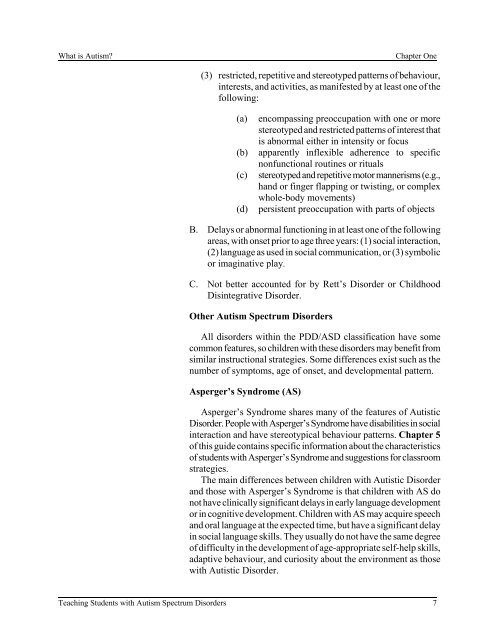Teaching Students with Autism Spectrum Disorders
Teaching Students with Autism Spectrum Disorders
Teaching Students with Autism Spectrum Disorders
Create successful ePaper yourself
Turn your PDF publications into a flip-book with our unique Google optimized e-Paper software.
What is <strong>Autism</strong>? Chapter One<br />
(3) restricted, repetitive and stereotyped patterns of behaviour,<br />
interests, and activities, as manifested by at least one of the<br />
following:<br />
(a) encompassing preoccupation <strong>with</strong> one or more<br />
stereotyped and restricted patterns of interest that<br />
is abnormal either in intensity or focus<br />
(b) apparently inflexible adherence to specific<br />
nonfunctional routines or rituals<br />
(c) stereotyped and repetitive motor mannerisms (e.g.,<br />
hand or finger flapping or twisting, or complex<br />
whole-body movements)<br />
(d) persistent preoccupation <strong>with</strong> parts of objects<br />
B. Delays or abnormal functioning in at least one of the following<br />
areas, <strong>with</strong> onset prior to age three years: (1) social interaction,<br />
(2) language as used in social communication, or (3) symbolic<br />
or imaginative play.<br />
C. Not better accounted for by Rett’s Disorder or Childhood<br />
Disintegrative Disorder.<br />
Other <strong>Autism</strong> <strong>Spectrum</strong> <strong>Disorders</strong><br />
All disorders <strong>with</strong>in the PDD/ASD classification have some<br />
common features, so children <strong>with</strong> these disorders may benefit from<br />
similar instructional strategies. Some differences exist such as the<br />
number of symptoms, age of onset, and developmental pattern.<br />
Asperger’s Syndrome (AS)<br />
Asperger’s Syndrome shares many of the features of Autistic<br />
Disorder. People <strong>with</strong> Asperger’s Syndrome have disabilities in social<br />
interaction and have stereotypical behaviour patterns. Chapter 5<br />
of this guide contains specific information about the characteristics<br />
of students <strong>with</strong> Asperger’s Syndrome and suggestions for classroom<br />
strategies.<br />
The main differences between children <strong>with</strong> Autistic Disorder<br />
and those <strong>with</strong> Asperger’s Syndrome is that children <strong>with</strong> AS do<br />
not have clinically significant delays in early language development<br />
or in cognitive development. Children <strong>with</strong> AS may acquire speech<br />
and oral language at the expected time, but have a significant delay<br />
in social language skills. They usually do not have the same degree<br />
of difficulty in the development of age-appropriate self-help skills,<br />
adaptive behaviour, and curiosity about the environment as those<br />
<strong>with</strong> Autistic Disorder.<br />
<strong>Teaching</strong> <strong>Students</strong> <strong>with</strong> <strong>Autism</strong> <strong>Spectrum</strong> <strong>Disorders</strong> 7

















